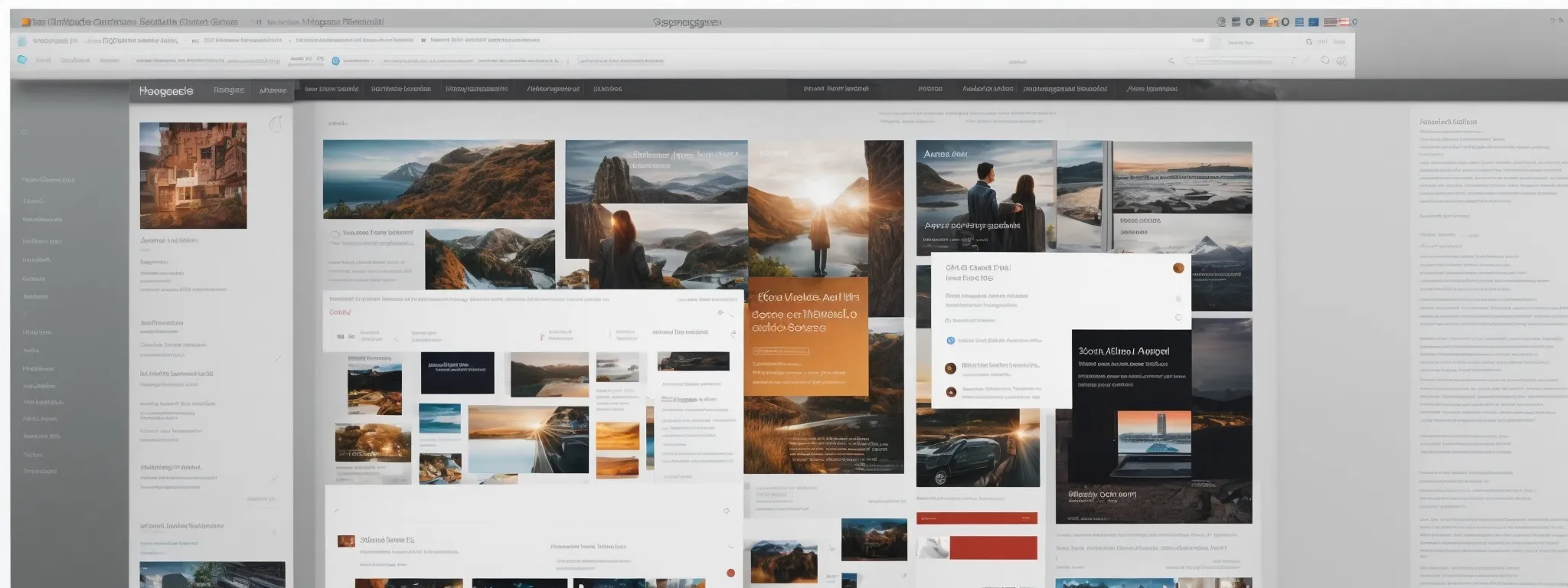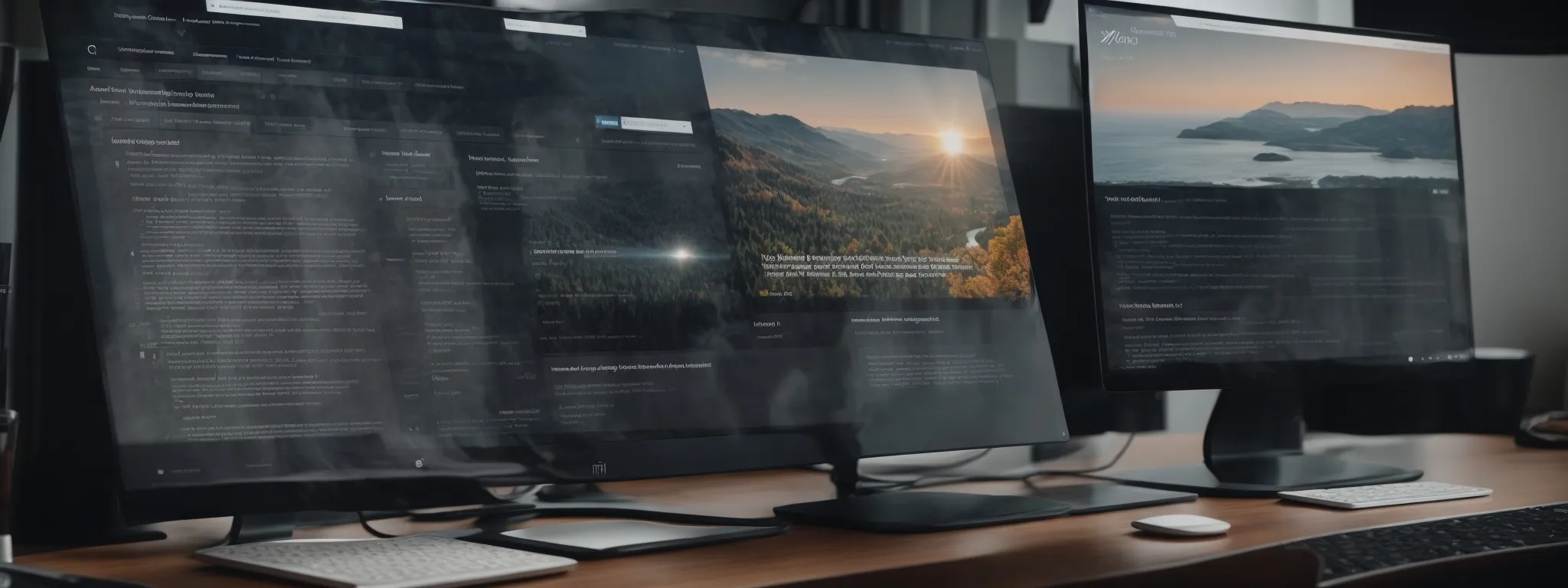SERP Features
Understanding SERP Features: A Comprehensive Overview In the dynamic landscape of search engine results pages (SERPs), understanding the various features beyond the traditional organic listings is critical […]
Understanding SERP Features: A Comprehensive Overview
In the dynamic landscape of search engine results pages (SERPs), understanding the various features beyond the traditional organic listings is critical for any brand, company, or SEO professional.
These features, from knowledge cards and image packs to local packs and rich snippets, shape how information is presented to users and, in turn, influence their interactions with search results.
By optimizing content with these features in mind, businesses can enhance their visibility and user experience.
As LinkGraph’s SEO services evolve, they prioritize adapting strategies to harness the power of these ever-changing SERP elements.
Keep reading to unlock a deeper comprehension of how SERP features can elevate a brand’s online presence.
Key Takeaways
- SERP Features Such as Featured Snippets and Knowledge Panels Can Significantly Affect a Website’s Organic Visibility and Click-Through Rates
- Understanding and Optimizing for SERP Features Is Essential for Businesses to Enhance Online Presence and User Engagement
- Mobile Optimization and Multimedia-Rich Content Are Increasingly Important for Ranking Favorably in SERP Features Across Devices
- LinkGraph’s SearchAtlas SEO Software Provides Valuable Analytics for Optimizing and Tracking a Brand’s Performance Within SERP Features
- Continuous Adaptation to Search Engine Advancements Is Crucial for Maintaining Competitive Advantage in Digital Marketing Strategies
Exploring the Variety of SERP Features

The digital landscape is continuously evolving, and with it, the structures populating the search engine results page become increasingly sophisticated.
Search Engine Results Page (SERP) features are specialized results that go beyond the traditional list of blue links, providing users with a more enriched and diverse search experience.
These features range from Featured Snippets, which succinctly answer queries, to Knowledge Panels that compile critical information at a glance.
Further enhancing search utility are Image Packs, which cater to visual-centric queries, and Top Stories, delivering timely news pieces that capture the pulse of current events.
Understanding the nuances of the People Also Ask (PAA) boxes can lead to deeper insights while Sitelinks augment site navigation, thereby streamlining the user journey.
An exploration of these SERP Features reveals the breadth and depth of information available to users and underscores the importance of optimizing content for a variety of query types to enhance visibility and engagement.
Defining What SERP Features Are
In the realm of Digital Marketing, SERP features are dynamic elements that display on the Search Engine Results Page in a myriad of formats, tailoring the presentation of information to match the intent behind the search query. These vary from organic results to paid advertisements and from rich snippets to local packs, each designed to enhance user experience and provide direct, actionable information.
Key to establishing an impactful online presence for any brand is a deep understanding of these SERP features, as they help guide content strategy and SEO efforts. By crafting content with the capacity to feature in these varied formats, businesses position themselves to capture the attention of their target audience more effectively and assert a dominant digital footprint.
The Role of Featured Snippets in SERPs
Featured snippets assume a significant role by delivering immediate answers to user inquiries directly on the search results page. These succinct blocks of text, often referred to as “answer boxes,” are extracted from web pages that Google deems capable of best answering the searcher’s question in a direct and concise manner.
They reside at the pinnacle of the search results, often coined as “Position Zero,” and serve to improve search efficiency by resolving queries without the need to click through to a website. This prominent positioning can lead to increased website traffic and heightened visibility for the source providing the snippet.
How the Knowledge Panel Enriches Search Results
The Knowledge Panel stands as a testament to Google’s commitment to streamlining the dissemination of detailed information. This SERP feature aggregates and displays a wealth of pertinent facts, figures, and summaries relevant to specific entities such as public figures, businesses, and landmarks within the search results.
By offering a comprehensive snapshot of crucial data at a single glance, the Knowledge Panel mitigates the need for excessive search result navigation, fostering a more efficient and satisfying user experience. Importantly, it assists brands in establishing credibility and trust by prominently presenting verified details to potential customers.
The Importance of Image Packs for Visual Queries
When users enter search terms with the intent to view, Image Packs serve as a vital SERP feature that displays a collection of relevant images within the search results. These curated visual sets offer immediate visual context and enhance the user’s ability to find information that may be better understood through imagery.
Positioned to quickly satisfy the visual searcher’s needs, Image Packs not only bolster search query fulfillment but also present significant opportunities for businesses that employ imagery as part of their SEO content strategy. Engaging image content may capture a notable share of user attention, thereby driving traffic back to the source website.
Top Stories and Their Impact on News-Oriented Searches
As the digital realm pulses with the constant beat of new developments, Top Stories emerge as a SERP feature tailored for those queries brimming with immediacy. They offer a streamlined avenue for users to access the latest news, ensuring that the most recent and relevant articles are at the forefront, meeting the searcher’s need for timeliness in today’s rapid news cycle.
Businesses and content creators can leverage Top Stories to amplify their authoritative voice on current events. By aligning with the factors that drive visibility in this dynamic feature, they carve a niche for themselves in a space where being first can often mean being foremost in the minds of their audience.
The Extensive Utility of People Also Ask Boxes
The ‘People Also Ask’ (PAA) boxes represent an invaluable resource for uncovering additional perspectives and queries related to the initial search term. This dynamic feature adapts to user interaction, continuously updating with new questions and answers as users engage, highlighting the interconnected nature of information and user curiosity.
Business entities can thus harness the predictive capacity of PAA boxes to anticipate and address a broader scope of customer inquiries. By integrating answers to these commonly searched questions into their content, companies can enhance their relevance in search discussions, often leading to improved click-through rates and user engagement.
Exploring the Benefits of Sitelinks for Navigation
Sitelinks expand the functionality of SERP entries by offering shortcut links to key sections of a website directly from the search results. This enhancement enables users to navigate smoothly and swiftly to the information they seek, bypassing the additional clicks that typically involve traversing through a website’s homepage or menu.
The incorporation of Sitelinks into a SERP listing augments a brand’s online visibility and can significantly improve the user experience by providing relevant subsections of a website that are likely to contain the precise content a searcher is pursuing. For businesses, Sitelinks not only increase the accessibility of their offerings but also present additional opportunities to engage with their audience efficiently.
The Evolution of SERP Features Over Time

As the alchemy of search engines continues to transmute the digital experience, the evolution of Search Engine Results Page (SERP) features represents a critical facet of this transformation.
From its inception, the SERP has been a dynamic canvas of innovation, with each subsequent update unfurling new features instrumental in sculpting today’s multimedia-rich search environment.
This continuous reinvention, mirroring the progression from sparse text-only listings to a tapestry of rich audiovisual displays, underscores the constant effort to propel user experience into new echelons of relevance and intuitiveness.
In navigating through the chapters of SERP advancements, one gains insight into the major updates that have paved the way for current search functionalities and anticipates the trends defining the future of Online Search.
A Brief History of SERP Features’ Advancements
The journey of SERP features commences with the rudimentary listings of the early search engines, which were primarily text-based and offered limited user interaction. The development of these features over time has blossomed into a sophisticated system where users not only find what they seek but often discover additional content they hadn’t initially considered.
One notable milestone was the introduction of Google’s Universal Search in 2007: a transformative feature allowing for the integration of news, video, images, and local information directly into the standard search listings. This innovation laid the foundation for a more expansive and interactive SERP, setting the stage for the continual enhancements that shape user experience today:
| Year | Update | Impact on SERP |
|---|---|---|
| 2007 | Universal Search | Blends various content types in search results |
| 2009 | Real-Time Search | Incorporates live updates and streaming content |
| 2012 | Knowledge Graph | Launches panels with structured data on entities |
| 2014 | HTTPS as Ranking Signal | Prioritizes secure websites in ranking |
| 2016 | Mobile-First Indexing | Begins using mobile versions for ranking and indexing |
| 2019 | BERT algorithm update | Improves understanding of natural language in search |
Analyzing Major Updates That Introduced New Features
As search technology has advanced, pivotal updates have played a key role in shaping the SERP features we encounter today. Google’s introduction of featured snippets in 2014, highlighted the search giant’s drive towards directly answering user queries within SERP, a step that significantly altered the landscape by emphasizing value-driven content.
The rollout of the mobile-first index in 2016 signaled another critical shift: Google now primarily uses the mobile version of a website’s content to rank pages from that site, to understand structured data, and to show snippets from those pages in results. This change crystallized the importance of responsive design and mobile optimization for all web entities:
- Featured Snippets (2014)
- Mobile-First Indexing (2016)
The Shift From Text-Only to Multimedia-Rich SERPs
Witnessing the pivotal transition from text-only to multimedia-rich SERPs chronicles the search engines’ relentless pursuit of an enhanced user interface. This trajectory charts a departure from the stark lists that once populated early search engine results pages, ushering in an era where varied content forms coalesce to cater to diverse user preferences and informational needs.
The augmentation of the SERP with engaging visual elements like images, videos, and interactive media elevates the browsing experience by providing users with a tapestry of content that is both informative and visually stimulating. Interpretations and demand for certain information have found new expressions through these dynamic formats, effectively changing the way search results educate and entertain the querying audience.
| Year | Milestone | Enhancement to SERP |
|---|---|---|
| Early 1990s to Mid-2000s | Text-Only Search Results | Basic search results with limited user interaction |
| 2007 | Universal Search Integration | Inclusion of news, images, and videos in results |
| 2010s | Rich Snippets and Knowledge Graph | Use of structured data to provide detailed previews |
| 2016 Onwards | Mobile-First & Visual Search | Focus on mobile optimization and visual content retrieval |
How SERP Features Influence User Experience

In the swiftly shifting realm of search engine usage, SERP features stand as pivotal elements that markedly refine the user experience.
These features, displayed prominently on a search engine results page, operate as gateways to enhanced information accessibility, facilitating the rapid acquisition of data with minimal effort.
They play an indispensable role in fact-checking by providing immediate access to verified snippets of information, and their influence extends to the tailored experiences of mobile and desktop users alike.
As users navigate through an increasingly complex sea of digital content, SERP features stand out as beacons of relevance, assisting them in quickly finding precise and authoritative information.
Enhanced Information Accessibility Through SERP Features
SERP features not only revolutionize how information is presented but also democratize its accessibility. Diverse formats such as featured snippets, local packs, and knowledge panels circumvent the complexities of traditional search, expediently directing users to the answers they seek.
With the implementation of these intuitive SERP elements, search engines acknowledge the varying degrees of user intent, catering to a spectrum of informational needs. The user’s journey to knowledge becomes less about sifting through myriad links and more about immediate enlightenment with respect to their search query.
The Role of SERP Features in Quick Fact-Checking
The intricacies of SERP features have made fact-checking a Streamlined Process for Users. Knowledge Panels and Featured Snippets promptly offer verified information, thereby curbing the spread of misinformation and empowering users to quickly discern the credibility of facts presented.
Entities, events, and concepts enclosed within the succinct confines of SERP features like Knowledge Graphs allow for the user to validate facts with a single glance. Google’s algorithms continuously crawl and index myriad sources to populate these features with up-to-date and trustworthy data:
| SERP Feature | Utility in Fact-Checking |
|---|---|
| Knowledge Panel | Delivers factual data about entities ensuring information reliability |
| Featured Snippets | Provides direct answers from authoritative sources minimizing misinterpretations |
In the age of instant information, SERP features play an essential role in fostering a well-informed user base. Their capacity to offer immediate, corroborated knowledge directly within search results ensures that facts remain at the forefront of user experience, transforming search engines into powerful tools for accurate information dissemination.
SERP Features’ Impact on Mobile Versus Desktop Experience
The nuances of SERP features exert a distinct influence on the user experience, contingent on whether the user is accessing information via mobile or desktop. On mobile devices, the layout and interactivity of SERP features are optimized for touch screens and smaller displays, which affects how information is consumed; features like local packs and knowledge panels are designed to deliver maximum value with minimal interaction.
In contrast, the desktop experience affords users a larger visual canvas, enabling more intricate details to be presented within SERP features. This difference often results in a more comprehensive display of information, such as data-rich panels or expanded sitelinks, which can guide users to their desired content with greater precision:
- Mobile SERPs are streamlined for fast and efficient on-the-go access
- Desktop SERPs provide an expansive view, conducive to in-depth research
Optimizing Content for SERP Feature Visibility

As the quest for dominance on the search engine results page intensifies, mastering the art of optimizing content for SERP feature visibility becomes crucial.
Savvy marketers and content creators understand that visibility in features such as Featured Snippets, the Knowledge Panel, and image or video searches can heighten a brand’s online presence and drive substantial traffic.
Embarking on this journey requires not only creativity and adherence to SEO best practices but also a strategic approach to Content Curation and Optimization tailored specifically to the criteria of these distinguished SERP elements.
Best Practices for Getting Featured in Featured Snippets
Securing a position within Featured Snippets necessitates content that provides clear, concise answers to commonly asked questions. Crafting informative headers followed by succinct, accurate information that directly addresses user queries can enhance the probability of being selected by search engines for these coveted snippet displays.
Interactive Collaboration With Compelling SEO Tools, such as SearchAtlas SEO software from LinkGraph, can bolster a brand’s visibility in Featured Snippets. Utilizing data-driven insights to understand and deliver content that aligns with search intent enables the realization of this strategic objective.
Tactics for Appearing in the Knowledge Panel
To secure visibility within the Knowledge Panel, it is crucial for a company to ensure its online presence is robust and well-documented across authoritative sources. Intertwining brand details with verified platforms, such as Google My Business, and harnessing structured data markup facilitate a brand’s eligibility for display in this SERP feature.
Having a comprehensive set of consistent, updated information establishes the foundation for featuring in the Knowledge Panel. The assimilation and enhancement of content across various credible channels magnify a brand’s prominence, prompting search engines to recognize and potentially showcase it within the Knowledge Panel:
| Channel | Action | Outcome |
|---|---|---|
| Google My Business | Claim and verify listing | Increases chances for local Knowledge Panel visibility |
| Structured Data Markup | Implement schema.org markup on the website | Enriches data for Knowledge Panel consideration |
| Third-Party Sources | Build strong brand mentions | Enhances overall brand authority in search algorithms |
Strategies for Leveraging Image and Video Searches
Leveraging image and video searches requires a keen understanding of metadata optimization. To enhance content discoverability through these channels, ensuring that images and videos include relevant file names, alt text descriptions, and supported structured data optimizes their visibility for search engine indexing and better aligns with visual search queries.
Incorporating video and image content that is not only relevant to the narrative but also rich in quality and tagged with pertinent keywords can substantially improve a webpage’s standing on the results page. Through adeptly engaging with these visual elements, businesses significantly boost their likelihood of featuring prominently within SERP features such as Image Packs and Video Carousels.
Understanding the Impact of SERP Features on SEO

As the digital expanse becomes increasingly competitive, an acute understanding of Search Engine Results Page (SERP) features is essential for enhancing a website’s Search Engine Optimization (SEO).
These features, proficient in transforming the landscape of the results page, play a pivotal role in determining a site’s visibility and user engagement.
With the capacity to influence click-through rates by offering users a snapshot of what they can expect on a webpage, SERP features effectively shape organic search visibility.
Consequently, modern SEO strategies must evolve to account for the prevalence of SERP components, adapting to how they intercept and fulfill user search intent while optimizing for those varying elements that dominate today’s search engine experiences.
How SERP Features Can Affect Click-Through Rates
The visibility of a website within SERP features such as Featured Snippets or Knowledge Panels can significantly influence its click-through rates (CTRs). A prominent display in these areas often fulfills the searcher’s need for quick answers, which can detract from traditional organic listings and redirect user engagement towards the featured content.
Conversely, when a website’s content is strategically positioned within these features, the Enhanced Visibility can lead to an uptick in CTRs. This elevation in prominence equips businesses with the potential to capture the initial attention of the searcher, thereby increasing the chances of a user visiting their site for more comprehensive information.
The Importance of SERP Features in Organic Visibility
The salience of SERP features in fortifying a website’s organic visibility is indispensable in the modern SEO landscape. By leveraging these innovative elements—whether through local pack listings or rich snippets—businesses can attain a superior presence on the results page, effectively magnifying their reach and enhancing audience engagement.
Occupying real estate on a search engine’s first page through SERP features implicitly communicates a badge of authority and relevance to users. LinkGraph’s SEO services adeptly navigate the intricacies of these SERP elements to maximize their clients’ organic exposure, ensuring the client’s content is optimally positioned to capture user interest amid the sea of search results.
Adapting SEO Strategies to the Presence of SERP Features
Adapting SEO strategies to the prevalence of SERP features necessitates a holistic approach that integrates technical SEO with insightful content creation. LinkGraph’s SEO services facilitate this integration by employing advanced analytics and SearchAtlas SEO software to align a brand’s online content with the criteria for SERP features, enhancing their chances of occupying prominent spaces on the results page.
Recognizing the dynamic nature of SERP feature algorithms, LinkGraph remains at the forefront of SEO Innovation, crafting strategies that leverage these features for maximum visibility. Their expert team devises SEO solutions that not only conform to the latest best practices but also anticipate shifts in search behaviors, ensuring that clients’ digital footprints evolve in tandem with search engine advancements.
Measuring the Performance of SERP Features

In the realm of digital competition, the understanding and measuring of SERP features’ performance stand as critical initiatives for businesses aiming to sharpen their online visibility and engagement.
Tackling this involves meticulous tracking of a brand’s stature within the Knowledge Panel and Featured Snippets, finely tuning the impact of navigational aids like Sitelinks and ‘People Also Ask’ boxes on user interaction, and leveraging sophisticated tools and metrics that quantify the effectiveness of these SERP components.
This data-driven approach to evaluating the influence of SERP features enables businesses to navigate the complex topography of online search with precision and adapt their strategies to the ever-changing algorithms of search engines.
Tracking Visibility in the Knowledge Panel and Snippets
Professionals at LinkGraph employ Tailored Analytics to monitor a brand’s presence within Knowledge Panels and Featured Snippets. The visibility of a company in these SERP features is essential, as they offer a direct conduit to heightened user engagement and authoritative brand positioning.
Utilizing tools like SearchAtlas SEO software, the team meticulously assesses a brand’s reach in these elevated snippets, ensuring the client’s content is encapsulating the essence of search queries. This focused tracking enables strategic refinements to a brand’s SEO tactics, optimizing for the best possible visibility in these critical SERP positions.
Assessing the Click-Through Impact of Sitelinks and PAA
LinkGraph’s advanced tools enable a precise assessment of the click-through impact associated with Sitelinks and People Also Ask (PAA) features. By tracking interaction with these navigational elements, they can reveal a clear picture of their role in steering organic traffic and improving user experience.
| SERP Feature | Objective | Impact on Click-Through Rates |
|---|---|---|
| Sitelinks | Enhance navigation to a website’s key pages | Can significantly elevate page visits to targeted areas of a website |
| People Also Ask (PAA) | Address related queries to satisfy user search intent | Potentially increases engagement by answering additional user queries |
The indicators derived from the analysis of Sitelinks and PAA features provide actionable insights for Refining SEO Campaigns. This exercise, integral to LinkGraph’s approach, heightens the strategic positioning of client content within the complex SERP landscape, fortifying the company’s online influence and audience connection.
Tools and Metrics for Evaluating SERP Feature Effectiveness
LinkGraph’s suite of SEO tools, such as SearchAtlas SEO software, is essential for assessing the effectiveness of SERP features. These tools offer advanced analytics and reporting capabilities that enable businesses to capture and analyze key performance indicators (KPIs) such as impressions, clicks, and click-through rates for features like Featured Snippets and Knowledge Panels.
The application of dedicated rank tracking software allows for monitoring the positions that a brand’s content holds within various SERP features over time. LinkGraph understands the importance of attributing organic traffic uplifts to specific SERP feature appearances, ensuring that businesses can quantify the value bestowed by enhanced visibility on the search engine results page.
Conclusion
In conclusion, comprehensively understanding SERP features is paramount for any successful digital marketing strategy.
These features, such as Featured Snippets, Knowledge Panels, and Image Packs, significantly influence how users engage with search results, impacting click-through rates and overall visibility.
By optimizing content to meet the criteria of these diverse elements, businesses can enhance their online presence, ensure their information is verified and accessible, and stay competitive in the fast-paced digital landscape.
Continually adapting SEO strategies to leverage SERP features effectively is critical, as they are integral in connecting users with relevant, authoritative content quickly and efficiently.
Assessing the performance of SERP features through advanced tools like SearchAtlas SEO software becomes indispensable, enabling businesses to refine their approach and measure the success of their optimization efforts.



















































































